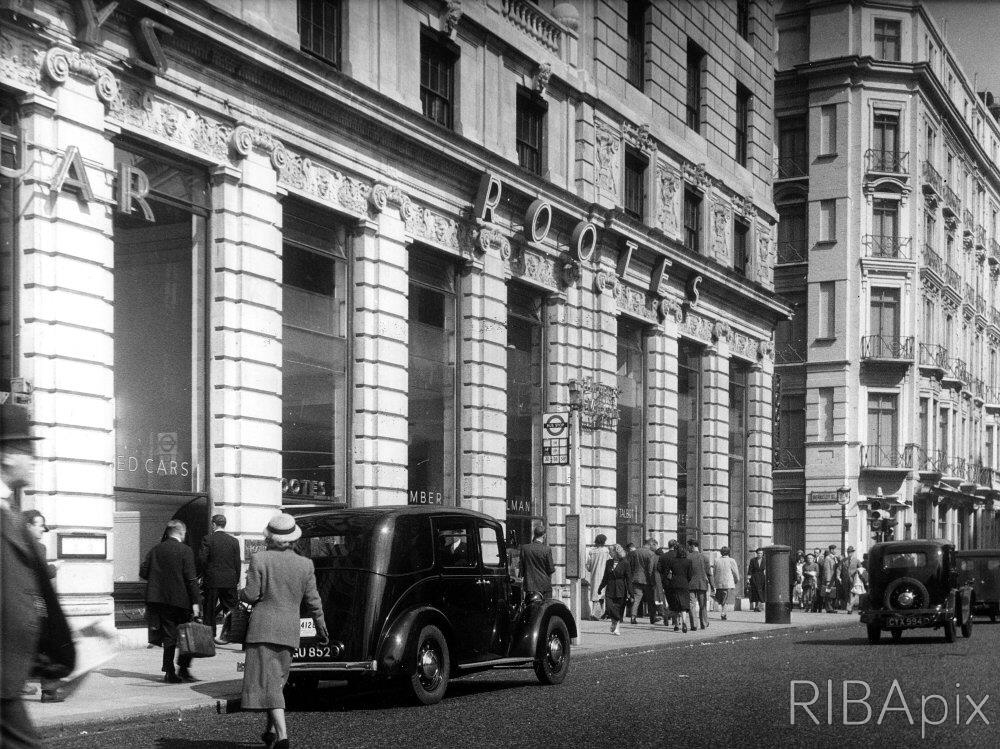Standing opposite Great Portland Street station at 385/7, Euston Road, on the corner of Bolsover Street, are the former showrooms and headquarters of auto dealer, Henlys Ltd.
Occupying a prominent corner site, the building is notable today only for its poor appearance, standing as a shadow of its former ‘Art Deco’ self, stripped of almost all original period features.

Founded in 1917 by Frank Hough (1888-1935) and Herbert Gerald Henly (1891-1973), by the mid-1920’s Henlys was already established as “England’s Leading Motor Agents”, and by the end of 1928, had listed on the London Stock Exchange.
Henlys already had two separate sites on nearby Great Portland Street, at numbers 91 and 155-157, which were used to display the group’s “medium and lower priced cars”, whilst the “more expensive cars” were on display at the flagship West End showroom, which occupied the ground floor of ‘Devonshire House’ on Piccadilly, W.1, standing directly opposite Green Park.

With a presence in both London and Manchester, the new showrooms on Euston Road became the group’s eighth branch, as they expanded rapidly during the interwar years.
The group’s new headquarters building, named ‘Henly House’ was officially opened at 3 p.m. on 14th May, 1928 by Captain Malcolm Campbell, who had recently broken the land speed record in the Napier-Campbell BlueBird at Daytona Beach, FL.
Able to accommodate more than 100 cars, the branch featured one of the largest showrooms in Europe. Those who attended the opening ceremony were also treated to the first public display of the new front wheel drive Alvis, for which Henlys was the sole London distributor.
Faced with Portland stone at street level, the new building was designed by Constantine & Vernon, a successful interwar partnership between Harry “Courtenay” Constantine (1884-1971) and George Vernon, F.R.I.B.A. (1870-1942).

The pair designed several notable office buildings in London’s West End including ‘Gilmoora House’, 57-61 Mortimer Street, W.1., which shares many design similarities with ‘Henly House’, most notably the prominent chamfered corner and turret.
For Henlys’ new headquarters, the architects made extensive use of traditional materials, with brown facing bricks complimented by red brick lintels. Portland stone was further incorporated into the facade, framing the upper storey windows.
Today the building is known as ‘Chesterfield House’ and forms part of The Langham Estate. Henlys have long since vacated their former headquarters, having been acquired in the mid-1980’s after a period of financial difficulty, with the once familiar name sadly consigned to the history books.
Whilst the building’s upper storeys are still in use as commercial office space, the original white metal casement windows, most likely sourced from the Crittall Manufacturing Co., Ltd. have been replaced with modern alternatives, which are entirely out of keeping with the original fabric of the building.
The former ground floor showroom space is now occupied by a Tesco Express. For reasons unknown, Tesco choose to obscure the windows in almost all of their Express stores with large stickers, which once again detracts from the period exterior, but is particularly ironic, given the original purpose of the building.
Modern Tesco signage above both the corner entrance door and windows is unfortunate, however where the facade at street level was previously covered by black granite panels, these have since been removed to reveal the original Portland stone once again.

Sadly, the building stands just outside of the City of Westminster’s Harley Street Conservation Area, and is understandably, not listed, given the loss of original features, which also includes a flag pole that once stood atop the turret.
Its loss would be an unfortunate outcome, given the history of the building and its original appearance. A sympathetic refurbishment and the reinstatement of the original features would be a far better outcome, yet sadly that feels unlikely.
January, 2020.
I suspect the reason why Tesco have covered over the windows is to create wall space for shelving inside. This increases the amount of stock that may be sold in a relatively small space.
LikeLike